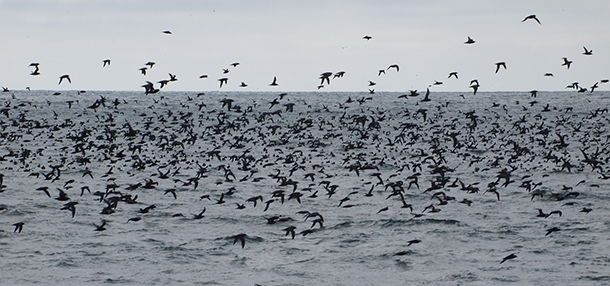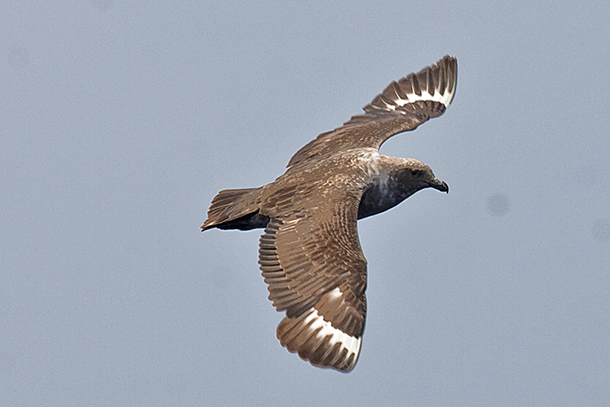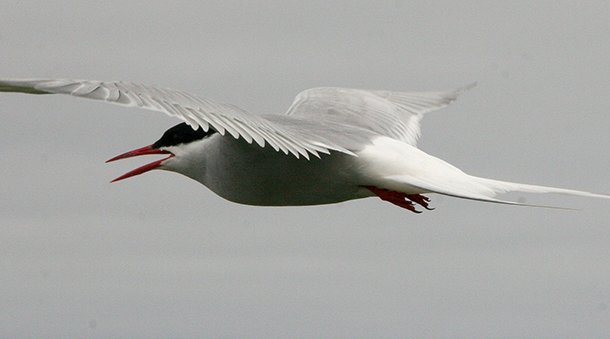Unseen Ocean Migrations
Air Date: Week of August 28, 2015

An enormous flock of Sooty Shearwaters travel south for New Zealand. (Photo: J. Maughn FCC)
As summer winds down, migratory birds in the Northern Hemisphere begin their trip south. Many species head down the flyways that cross the US, but as BirdNote’s Michael Stein reports, many travel unseen offshore.
Transcript
BIRDNOTE®/ VAST UNSEEN MIGRATION
[MUX - BIRDNOTE® THEME]
CURWOOD: As we slide increasingly away from the summer vacation travel season – many birds are contemplating trips of their own – some even go halfway around the world. And though many of us like to watch geese and the like heading south down the great flyways that cross the country – there’s a massive migration that we miss, as Michael Stein explains in today’s BirdNote®.
[Sounds of waves, gulls]

South Polar Skua heads for its winter breeding grounds on Antarctic coasts near the Pacific, Indian and Atlantic Oceans (Photo: Tony Morris FCC)
STEIN: Late August is a fine time to walk the ocean beach. Weather is growing mild; gulls jabber overhead; waves gently lap the sand. But look out to sea: if your eyes could take you beyond the horizon, you would see an astonishing scene.
A vast migration is taking place. Offshore, over the Pacific and Atlantic Oceans, millions of seabirds are on the move. Most are heading south, migrating past the US coastlines in August and September.
Fierce, predatory jaegers that nested on the Arctic tundra are flying south to winter on tropical oceans. Arctic Terns and skuas are departing on an epic journey, flying all the way to Antarctic waters.
[Arctic Tern]
STEIN: Shearwaters in the tens of millions leave northern oceans to nest in the Southern Hemisphere, many near New Zealand. Even puffins bid farewell to their shoreline nesting cliffs now, scattering widely across the open ocean for the winter.
[Sounds of waves, gulls]
STEIN: Meanwhile, back on the beach with the warm August sand between our toes, we relax. We squint out into the distant blue. Above the glimmering sea, is that a single shearwater we see, tipping above the horizon? A straggler, maybe? And a clue to that immense migration taking place just beyond our sight.
I am Michael Stein.

An Arctic Tern migrates from Arctic and sub-Arctic regions down to its breeding grounds on the Antarctic coast. Depending on the birds’ destinations, roundtrips average between 44,100 and 56,000 miles. (Photo: Joseph Slocum FCC)
###
Written by Bob Sundstrom
Bird sounds provided by The Macaulay Library of Natural Sounds at the Cornell Lab of Ornithology, Ithaca, New York. Ring-Billed Gull 169780 recorded by Jay MacGowan; Arctic Tern 138232 recorded by Gerrit Vyn.
Surf sounds: Surf Small Detailed SFX #21; Surf Moderate SFX #23; and Surf Distant SFX #27 from Nature Essentials recorded by Gordon Hempton of QuietPlanet.com
BirdNote’s theme music was composed and played by Nancy Rumbel and John Kessler.
Producer: John Kessler
Executive Producer: Dominic Black
© 2015 Tune In to Nature.org August 2015 Narrator: Michael Stein
http://birdnote.org/show/vast-unseen-migration
Links
More about overseas bird migrations on BirdNote
The amazing 1,600-mile, open-water migration of half-ounce songbirds
Living on Earth wants to hear from you!
Living on Earth
62 Calef Highway, Suite 212
Lee, NH 03861
Telephone: 617-287-4121
E-mail: comments@loe.org
Newsletter [Click here]
Donate to Living on Earth!
Living on Earth is an independent media program and relies entirely on contributions from listeners and institutions supporting public service. Please donate now to preserve an independent environmental voice.
NewsletterLiving on Earth offers a weekly delivery of the show's rundown to your mailbox. Sign up for our newsletter today!
 Sailors For The Sea: Be the change you want to sea.
Sailors For The Sea: Be the change you want to sea.
 The Grantham Foundation for the Protection of the Environment: Committed to protecting and improving the health of the global environment.
The Grantham Foundation for the Protection of the Environment: Committed to protecting and improving the health of the global environment.
 Contribute to Living on Earth and receive, as our gift to you, an archival print of one of Mark Seth Lender's extraordinary wildlife photographs. Follow the link to see Mark's current collection of photographs.
Contribute to Living on Earth and receive, as our gift to you, an archival print of one of Mark Seth Lender's extraordinary wildlife photographs. Follow the link to see Mark's current collection of photographs.
 Buy a signed copy of Mark Seth Lender's book Smeagull the Seagull & support Living on Earth
Buy a signed copy of Mark Seth Lender's book Smeagull the Seagull & support Living on Earth

